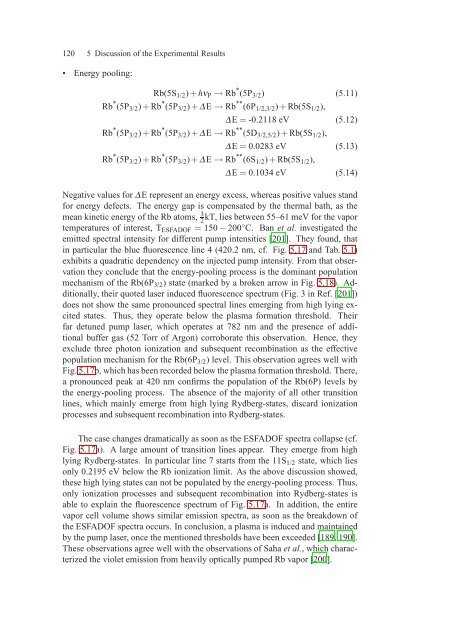Assessment of a Rubidium ESFADOF Edge-Filter as ... - tuprints
Assessment of a Rubidium ESFADOF Edge-Filter as ... - tuprints
Assessment of a Rubidium ESFADOF Edge-Filter as ... - tuprints
Create successful ePaper yourself
Turn your PDF publications into a flip-book with our unique Google optimized e-Paper software.
120 5 Discussion <strong>of</strong> the Experimental Results<br />
• Energy pooling:<br />
Rb(5S 1/2 )+hν P → Rb * (5P 3/2 ) (5.11)<br />
Rb * (5P 3/2 )+Rb * (5P 3/2 )+∆E → Rb ** (6P 1/2,3/2 )+Rb(5S 1/2 ),<br />
∆E = -0.2118 eV (5.12)<br />
Rb * (5P 3/2 )+Rb * (5P 3/2 )+∆E → Rb ** (5D 3/2,5/2 )+Rb(5S 1/2 ),<br />
∆E = 0.0283 eV (5.13)<br />
Rb * (5P 3/2 )+Rb * (5P 3/2 )+∆E → Rb ** (6S 1/2 )+Rb(5S 1/2 ),<br />
∆E = 0.1034 eV (5.14)<br />
Negative values for ∆E represent an energy excess, where<strong>as</strong> positive values stand<br />
for energy defects. The energy gap is compensated by the thermal bath, <strong>as</strong> the<br />
mean kinetic energy <strong>of</strong> the Rb atoms, 3 2kT, lies between 55–61 meV for the vapor<br />
temperatures <strong>of</strong> interest, T <strong>ESFADOF</strong> = 150 − 200 ◦ C. Ban et al. investigated the<br />
emitted spectral intensity for different pump intensities [201]. They found, that<br />
in particular the blue fluorescence line 4 (420.2 nm, cf. Fig. 5.17 and Tab. 5.1)<br />
exhibits a quadratic dependency on the injected pump intensity. From that observation<br />
they conclude that the energy-pooling process is the dominant population<br />
mechanism <strong>of</strong> the Rb(6P 3/2 ) state (marked by a broken arrow in Fig. 5.18). Additionally,<br />
their quoted l<strong>as</strong>er induced fluorescence spectrum (Fig. 3 in Ref. [201])<br />
does not show the same pronounced spectral lines emerging from high lying excited<br />
states. Thus, they operate below the pl<strong>as</strong>ma formation threshold. Their<br />
far detuned pump l<strong>as</strong>er, which operates at 782 nm and the presence <strong>of</strong> additional<br />
buffer g<strong>as</strong> (52 Torr <strong>of</strong> Argon) corroborate this observation. Hence, they<br />
exclude three photon ionization and subsequent recombination <strong>as</strong> the effective<br />
population mechanism for the Rb(6P 3/2 ) level. This observation agrees well with<br />
Fig. 5.17b, which h<strong>as</strong> been recorded below the pl<strong>as</strong>ma formation threshold. There,<br />
a pronounced peak at 420 nm confirms the population <strong>of</strong> the Rb(6P) levels by<br />
the energy-pooling process. The absence <strong>of</strong> the majority <strong>of</strong> all other transition<br />
lines, which mainly emerge from high lying Rydberg-states, discard ionization<br />
processes and subsequent recombination into Rydberg-states.<br />
The c<strong>as</strong>e changes dramatically <strong>as</strong> soon <strong>as</strong> the <strong>ESFADOF</strong> spectra collapse (cf.<br />
Fig. 5.17a). A large amount <strong>of</strong> transition lines appear. They emerge from high<br />
lying Rydberg-states. In particular line 7 starts from the 11S 1/2 state, which lies<br />
only 0.2195 eV below the Rb ionization limit. As the above discussion showed,<br />
these high lying states can not be populated by the energy-pooling process. Thus,<br />
only ionization processes and subsequent recombination into Rydberg-states is<br />
able to explain the fluorescence spectrum <strong>of</strong> Fig. 5.17a. In addition, the entire<br />
vapor cell volume shows similar emission spectra, <strong>as</strong> soon <strong>as</strong> the breakdown <strong>of</strong><br />
the <strong>ESFADOF</strong> spectra occurs. In conclusion, a pl<strong>as</strong>ma is induced and maintained<br />
by the pump l<strong>as</strong>er, once the mentioned thresholds have been exceeded [189, 190].<br />
These observations agree well with the observations <strong>of</strong> Saha et al., which characterized<br />
the violet emission from heavily optically pumped Rb vapor [200].
















